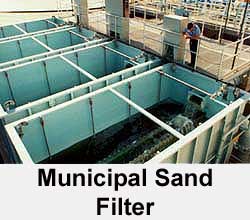
One of the most popular forms of solids removal in recirculation aquaculture is the up flow bead filter. Bead filters efficiently remove solids down to 50 microns and they do so without excessive loss of water to the system. In order to clean them, however, water flow must be stopped for the back flushing procedure which must be done manually unless complicated automatic controls are installed. Bead filters employ floating polyethylene beads about the size of a BB. These beads are contained in a closed tank by a screen. As the water flows upward through the beads, solids are trapped in the interstitial spaces. As the beads trap solids, flow becomes restricted, slowing the movement of water through the system. At this point, the bead filter must be back flushed. Back flushing involves stopping the flow, stirring the beads (either with a motor-driven propeller or a stream of bubbles) which dislodges the trapped solids, and then allowing the solids to settle to the bottom of the bead filter where they are drained out. Care must be taken not to drain out the floating beads. In addition to solids removal, the beads provide a large area of substrate for nitrification bacteria to colonize. In lightly loaded systems, bead filters may provide all ammonia removal necessary.
 |
 |
Most municipal water systems clarify the potable water with down flow sand filters. This technology can also be used in recirculation systems with some modification. Sand filters work by allowing water to percolate down through beds of sand that trap particulates. In a large scale municipal filter, sand is really only the top layer of a sand filter. There are actually layers of granule sizes from large gravel at the bottom to sand on top. This is termed a mixed bed. The progressively smaller particle sizes allow the large particles to rest on a grate while supporting slightly smaller sizes above them, thus the sand stays on top and does not wash out of the system. When sand filters clog they must be back flushed. This requires stopping the flow and sending water up through the filter to flush out the trapped particles. In a mixed bed, when the back flush is turned off the different granules settle out in order of density and the bed retains its layered configuration. Smaller sand filters contained in vessels rather than in large tanks are used to clarify swimming pools. In either case, the micron size that a sand filter removes depends on the size of the sand on top. The smaller the granule size, the smaller the solids particle that is trapped. As stated earlier, recirculation aquaculture does not require clear water and so the "sand" filters employed contain larger particles than municipal or swimming pool versions. In fact, sand filters used in recirculation aquaculture may not contain sand and may not have a mixed bed. They often resemble bead filters, with the differences being that the media sinks instead of floats, the flow of water is down instead of up, and the back flush plumbing is reversed.